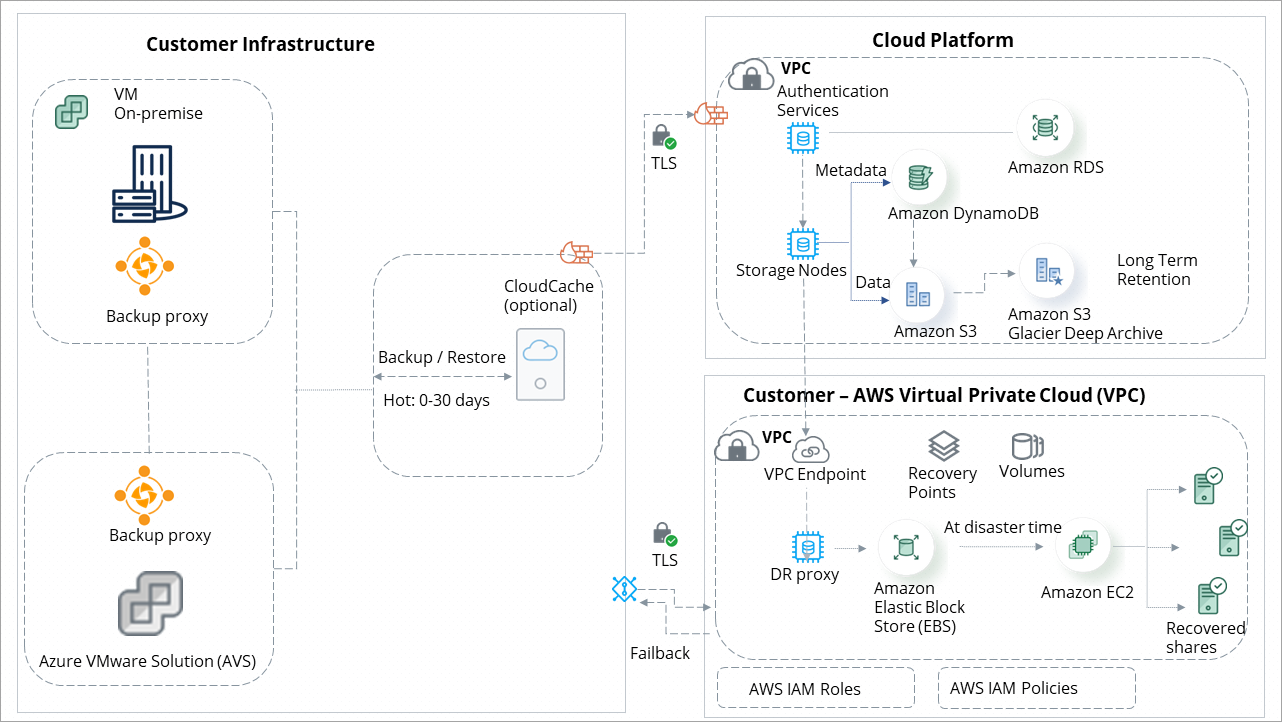Druva and Azure VMware Solution
Druva can back up virtual machines created in Azure VMware Solution (AVS) Software-Defined Data Center (SDDC) similar to the on-premise vSphere-based data center.
The backed-up virtual machines can be restored to:
- Same AVS SDDC from where they were backed up.
- Different Public Cloud SDDC than the one it was backed up on.
- Any on-premise VMware data center.
Similarly, virtual machines backed up from an on-premise data center can be restored to a AVS SDDC.
Capabilities
Druva offers the following capabilities with the AVS integration:
- Uses native VMware API to back up and restore data.
- Leverages VMware CBT to track incremental changes.
- Offers file-level recovery to a virtual machine.
- Leverages hot add transport mode for backups.
- Enables configuration of virtual machines based on tags, datastores, clusters, and automated policy.
Architecture
The following diagram illustrates the architecture:

As illustrated in the diagram:
- Data is directly backed up to the cloud.
- To back up and restore virtual machines, you have to deploy the Druva Backup proxy. The Druva Backup proxy is the client-side component that detects the virtual machines running on your setup and executes the backup and restore requests from the Druva Cloud.
- Data is processed at the Backup proxy end for deduplication and the deduplicated data is then sent over to the Druva Cloud.
Note: AVS does not support the NBD mode of transport for data transfer (backup over production LAN) and instead uses the hot-add transport mode for backups.
- By default, data flows over the public network (restricted to the AWS environment) to the Druva Cloud.
- Once that data is backed up to the Druva Cloud, it is typically stored in warm storage. But, if you need to hold data for a longer period, Druva offers the ability to automatically tier that data to cold storage. For more information, see About Long Term Retention.
- Disaster recovery in your AWS VPC. It is automated and secure and helps you meet RTOs in minutes. For more information, see Introduction to Druva DraaS.
Assumptions
- To ensure clear understanding, we use VMware terms as defined in the VMware Technical Publications Glossary available at http://www.vmware.com/support/.
- To ensure uninterrupted experience while configuring Druva for your VMware setup, we recommend that you familiarize yourself with the VMware documentation in addition to following the VMware-specific instructions within the Druva documentation. The full set of instructions for VMware is available at https://www.vmware.com/support/services.html.
Steps to configure Azure VMware on Public Cloud with Druva
- Ensure Azure VMware Solution (AVS) SDDC firewall rules are configured to enable http/https traffic over port 443 and NTP port 123 for communication through Compute and Management Gateways.
- The Backup proxy communicates with Druva on port 443. The communication is outbound only and you need to create an inbound traffic rule. The Backup proxy also communicates with the vCenter on port 443 to understand the VMware hierarchy and communicates with the virtual machines to perform backups and restores. For more information, see Prerequisites to install the Backup proxy. The Backup proxy also uses port 123 outbound connection to synchronize time with the NTP server.
- Deploy the Backup proxy and Register your VMware setup with Druva. For more information, see Deploy VMware proxy using VMware Proxy Deployer.
- Configure your virtual machines for backup. For more information, see Configure Virtual Machines for Backup.
Note: For more information on deploying AVS, see https://docs.microsoft.com/en-us/azure/azure-vmware/

